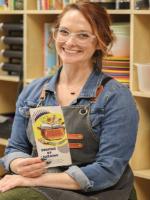
Event Information

BASIC OVERVIEW:
Presentation: Participants will hear student, family, and community partners’ first-hand accounts of how Cooking Up Learning has been impactful. The presenter will then share her experience developing the program from the ground up.
Group hands-on activity: After the presentation, participants will work in small groups to walk through an integrated culinary activity targeted for elementary students.
Q&A session: Participants will be given time to ask questions regarding Cooking Up Learning. Presenter will share tips and tricks to start the program within their own classrooms and districts.
BREAKDOWN OUTLINE (times may change based on selected presentation style):
I. Introduction (10 minutes)
Content: Brief overview of Cooking Up Learning.
Importance of culinary education in elementary settings.
Engagement: Icebreaker: Ask participants to share their favorite childhood food memory.
Use a visual presentation with vibrant images of cooking in the classroom.
II. The Why: Importance of Culinary Education (10 minutes)
Content: Discussion of benefits: engagement, real-world applications, and cross-curricular connections.
Testimonials from students, families, and community partners.
Engagement: Use of short video clips or audio testimonials.
Quick group discussion: “What barriers do you see in integrating culinary arts into your teaching?”
III. Culinary Connections Across Subjects (15 minutes)
Content: Overview of how culinary arts tie into various subjects: history, science, communication, and STEM.
Examples of lessons that can be taught through culinary projects.
Engagement: Interactive brainstorming session:
Participants will break into small groups by grade level.
Each group brainstorms culinary-related PBL topics and shares with the larger group.
Process: Use sticky notes for each idea, which can be placed on a large poster board.
IV. Practical Implementation: Getting Started (15 minutes)
Content: Steps to begin integrating culinary arts in the classroom.
Discussion on building authentic community partnerships.
Engagement: Hands-on activity:
Participants create a “starter plan” for one culinary lesson.
Provide a template for planning: materials needed, potential community partners, and expected outcomes.
V. Overcoming Challenges: Resources & Support (5 minutes)
Content: Share tips on managing time, resources, and budget for culinary projects.
Provide a list of essential materials and resources for teachers.
Engagement: Q&A session:
Participants can share their concerns or challenges and brainstorm solutions as a group.
Process: Encourage peer-to-peer sharing by inviting participants to offer suggestions based on their experiences.
VI. Wrap-Up and Closing (5 minutes)
Content: Recap of key points discussed.
Highlight the importance of collaboration between teachers and community.
Engagement: Reflection activity:
Ask participants to write down one actionable takeaway on an index card to share with the group.
1) Research completed to emphasize the need for culinary integration professional development: https://drive.google.com/file/d/1JF77l-7lErYfCdlV5Sneb-BP906VWi5n/view?usp=sharing
Research:
Beinert, C., Øverby, N. C., & Vik, F. N. (2021). Project LifeLab Food and Health - Innovative Teaching for the Future: Development of Student Active Learning Tasks for Home Economics Education in the 21st Century. CEPS Journal, 11(4), 63–80. https://doi.org/10.26529/cepsj.1179
Deagon, J. R. (2021). I Do, We Do, You Do Home Economics: Explicit Instruction Connecting Content with Ideology. CEPS Journal, 11(4), 135–150. https://doi.org/10.26529/cepsj.1188
Haden, R. (2006). “Pandora's Lunchbox” On Esthetic Education, Children, and Food. Food, Culture & Society, 9(3), 265-274.
Institute of Medicine, Board on Children, Y. and F., Food and Nutrition Board, Sheila Moats, & Steve Olson. (2013). Nutrition Education in the K-12 Curriculum : The Role of National Standards: Workshop Summary. National Academies Press.
Kostanjevec, S., & Kozina, F. L. (2021). Home Economics Education as Needed in the 21st Century. CEPS Journal, 11(4), https://cepsj.si/index.php/cepsj/issue/view/46/11-4
McGregor, S. L. T. (2022). Justifying Home Economics: Fight the right war. International Journal of Home Economics, 15(2), 33–44.
Moorhouse, B. (2017). Cooking with children. English Teaching Professional, 109, 26–28.
Nickols, S. Y., & Kay, G. (2015). Remaking Home Economics : Resourcefulness and Innovation in Changing Times. University of Georgia Press.
Reese, S. (2004). Culinary Arts: Education for a Taste of Success. Techniques: Connecting Education & Careers, 79(4), 31–39.
Renwick, K., & Edstrom, M. B. (2022). Finding Home Economics When It Has Never Been Lost: A Journey of Discovery for Pre-Service Teachers. International Journal of Home Economics, 15(1), 171–182.
Walters, L. M., & Stacey, J. E. (2009). Focus on Food: Development of the “Cooking with Kids” Experiential Nutrition Education Curriculum. Journal of Nutrition Education & Behavior, 41(5), 371–373. https://doi.org/10.1016/j.jneb.2009.01.004
Zhang, L. Y., Simonds, K., & Matthews, J. (2021). “We should at least have basic survival skills, right?”: young males support mandatory food skills education. Health Education, 121(6), 541–553. https://doi.org/10.1108/HE-06-2021-0098
